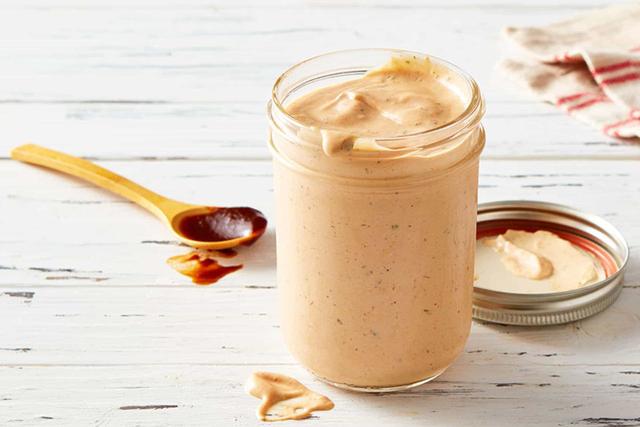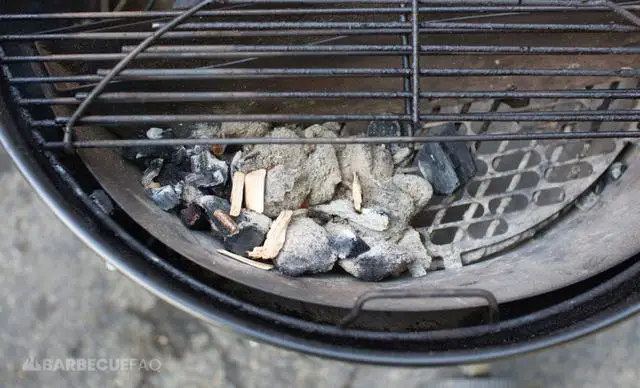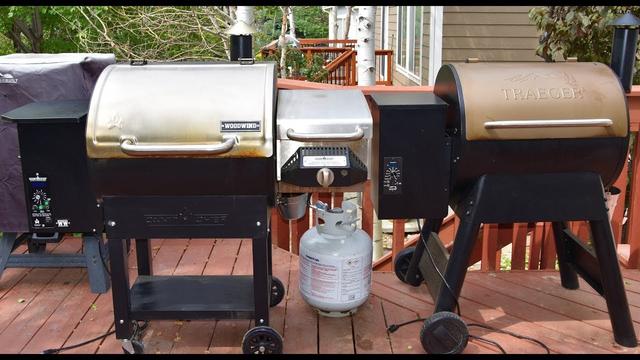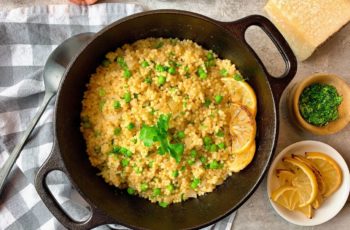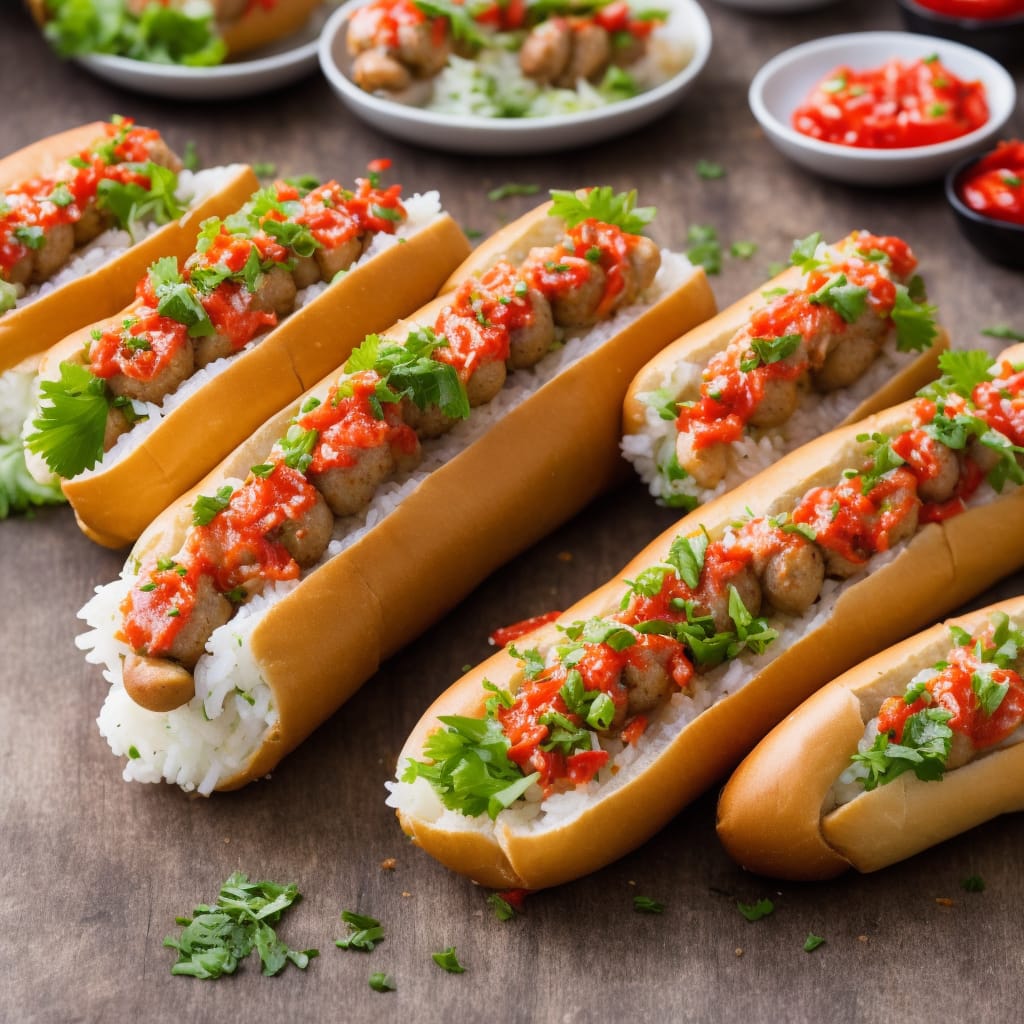
“Sizzling Showdown: Sirloin vs Ribeye – Unraveling the Battle of Beef Cuts! Discover the key differences and mouthwatering qualities of these two popular steaks, as we delve into their tenderness, marbling, and flavor profiles. Whether you’re a steak connoisseur or simply seeking the perfect cut for your next grill-out, join us on this delicious journey to decide which reigns supreme – Sirloin or Ribeye!”
WHAT IS A SIRLOIN STEAK?
A sirloin steak is a cut of beef that comes from the back part of the cow, starting just behind the ribs and ending before the rump area. It is a large piece of steak that can be cut into different types, including the top sirloin, T-bone steak, and sirloin tip roast. The top sirloin is the most common cut of sirloin steak.
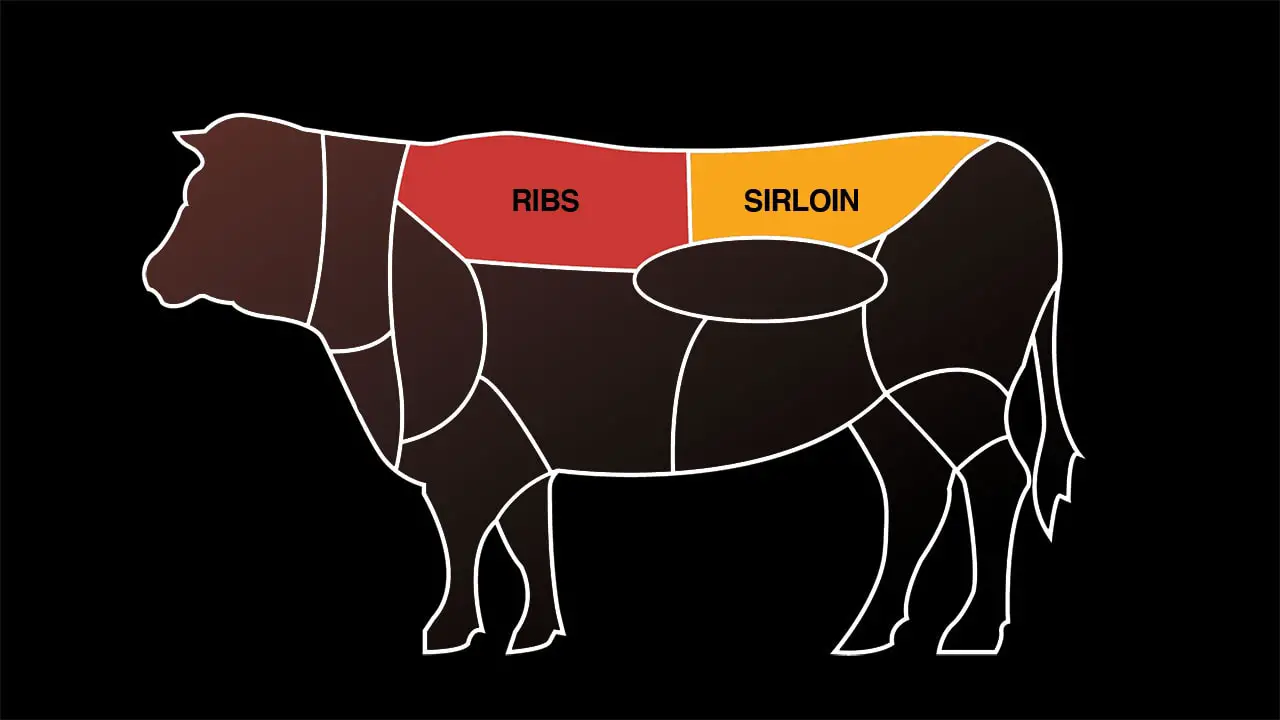
The meat in a sirloin steak primarily comes from the groups of gluteus muscles, such as gluteus medius, gluteus accessorius, and gluteus profundus. These muscles are leaner compared to the ribeye steak and have less fat content and distinctive marbling. While slightly less tender than ribeye due to lower fat and connective tissue, sirloin is not dry or tough and has a rich smell and adequate tenderness. It is known for its beefy flavor and characteristic chewy texture.
OTHER NAMES OF SIRLOIN STEAK
Sirloin steak is also known by several other names, including New York Strip, Kansas City Strip, Omaha Strip, and club steak.
WHAT IS A RIBEYE STEAK?
A ribeye steak is a cut of beef that comes from the prime rib area of the cow, specifically from the 6th to 12th rib. It is known for its exceptional flavor and tenderness, making it one of the most sought-after cuts of steak. The ribeye is composed mainly of the longissimus dorsi muscle, with a characteristic cap of spinal muscle separated by a layer of fat. This intramuscular fat creates marbling, which enhances the richness and juiciness of the steak. The ribeye steak can be boneless or bone-in, with different variations in names such as cowboy steak or tomahawk steak.
WHY IS IT CALLED RIBEYE STEAK?
The ribeye steak got its name because it is cut from the best portion of the rib, which is the centremost part of the cow, also known as the “eye”. Hence the name Ribeye.
TYPES OF RIBEYE STEAK
Ribeye steak comes in two types: boneless and bone-in. The bone-in ribeye is sometimes referred to as the cowboy steak, while a ribeye steak with the entire length of the bone intact is called a tomahawk steak. These variations offer different experiences in terms of cooking and presentation.
In addition to these variations, ribeye steak is also known by several other names such as Spencer Cut, beauty steak, Scotch filet, and Delmonico. Each name may be associated with specific regions or preparation methods.
OTHER NAMES OF RIBEYE STEAK
Ribeye steak is also known by several other names, including Spencer Cut, beauty steak, Scotch filet, and Delmonico.
DIFFERENCE BETWEEN SIRLOIN AND RIBEYE
Sirloin and ribeye are two popular cuts of steak that differ in various aspects. Firstly, the location from which they are cut differs. Sirloin comes from the back part of the cow, starting just behind the ribs and ending before the rump area. On the other hand, ribeye is cut from the prime rib area of the cow, specifically from rib 6th to rib 12th.
The composition of these two cuts also varies. Sirloin is mainly composed of leaner gluteus muscles, such as gluteus medius, gluteus accessorius, and gluteus profundus. It has less fat content and marbling compared to ribeye. In contrast, ribeye is made up of the longissimus dorsi muscle with a characteristic cap of spinal muscle separated by a layer of fat. This intramuscular fat creates marbling and gives ribeye its rich flavor and juiciness.
In terms of tenderness, ribeye is generally more tender than sirloin due to its lower fat content and connective tissue. However, sirloin is still adequately tender and has a characteristic chewy texture. The flavor also differs between these cuts; while sirloin has a more intense beefy flavor with less fattiness, ribeye offers a richer flavor due to its marbling and thick fat layer.
FAT CONTENT AND MARBLING
Sirloin steak has a lot less fat content and marbling compared to ribeye. This is because sirloin comes from the more exercised area of the cow, while ribeye comes from the less exercised area. The ribeye has much better marbling and fat content than the sirloin, which contributes to its rich flavor and juiciness.
Sirloin steak is slightly less tender than ribeye due to its lower fat and connective tissue content. However, it is not dry or tough, but rather adequately tender with a characteristic chewy texture. On the other hand, ribeye steak is known for its incredible tenderness, as it comes from a less exercised part of the cow.
The flavor of a steak depends on its fat content and marbling. Ribeye has a much richer flavor than sirloin due to its high fat marbling. The intramuscular fat in ribeye creates an incredible marbling that enhances the taste when cooked, resulting in a strong and juicy beefy flavor. Sirloin, though leaner, still offers a rich beefy flavor.
Since sirloin has less fat than ribeye, it is lower in calories. Sirloin is a great source of protein with fewer calories compared to ribeye steak. If you are conscious about your calorie intake but still want to enjoy a flavorful steak, sirloin would be the better choice.
Ribeye steak tends to be more expensive than sirloin due to its higher quality marbling and tenderness. If cost is a factor for you, sirloin may be a more budget-friendly option while still delivering great flavor and tenderness.
LEANNESS
Sirloin is a lean cut of steak, with less fat content compared to ribeye. It comes from the buttock area of the cow, which is a more exercised part of the animal. In contrast, ribeye is a more fatty cut of steak due to its marbling and comes from a less exercised area of the cow.
Ribeye steak is generally more tender than sirloin. The meat in ribeye comes from an area that is less exercised, resulting in a softer texture. Sirloin, on the other hand, can be slightly less tender due to its lower fat and connective tissue content.
Ribeye has a richer flavor compared to sirloin. The marbling in ribeye creates a higher fat content, which enhances the taste and juiciness of the steak. Sirloin has a leaner profile and may not have as intense or pronounced flavor as ribeye.
Sirloin has fewer calories compared to ribeye due to its lower fat content. It is a good choice for individuals watching their calorie intake while still enjoying a flavorful steak.
Sirloin is considered a healthier option in terms of nutritional value. It is leaner and provides high-quality protein along with vitamins and minerals such as vitamin B6, vitamin B12, zinc, phosphorus, and iron.
Ribeye tends to be more expensive than sirloin due to its higher marbling and tenderness. If budget is a consideration, sirloin may be a more cost-effective option without compromising on taste.
TENDERNESS
Sirloin steak, although slightly less tender than ribeye due to its lower fat and connective tissue content, is not dry or tough. It has a rich smell and is adequately tender, with a characteristic chewy texture. The sirloin’s leaner composition and exercise of the muscle groups make it a slightly tougher cut compared to the buttery tenderness of ribeye.
FLAVOR
The flavor of sirloin steak is rich and beefy, but not as intense as the ribeye. With its lower fat content and marbling, the sirloin offers a leaner, more subtle taste. However, dry-aging can enhance its flavor to be equally enriched as a ribeye while maintaining its distinct taste.
While slightly less tender than the ribeye due to less fat and connective tissue, the sirloin is still adequately tender. It has a characteristic chewy texture and is not dry or tough. On the other hand, the ribeye’s tenderness is exceptional due to being cut from a less exercised area of the cow.
Sirloin steak has comparatively fewer calories than ribeye steak due to its leaner composition with less fat. It is an excellent source of protein while being lower in fat content.
Ribeye steak is generally more expensive than sirloin steak of the same size due to its extra marbling and tenderness. The melt-in-your-mouth experience of a ribeye makes it worth the higher price for those seeking a top-notch steak experience.
Sirloin steak can be cooked both on the grill and in a pan, offering versatility in preparing different dishes. Ribeye steak is best cooked in a pan due to its higher fat content, which makes grilling riskier.
In conclusion, choosing between sirloin and ribeye depends on personal preference. Sirloin offers a nutritious and beefy-flavored option with lower calories and versatility in cooking methods. Ribeye provides an indulgent, juicy, and flavorful experience that comes at a higher price point.
CALORIES
Sirloin steak is a lean cut of meat with less fat content compared to ribeye. It is a great source of protein and is lower in calories. Ribeye, on the other hand, has more marbling and fat content, which means it has more calories than sirloin. If you are watching your calorie intake, sirloin is a better option for you.
NUTRITIONAL VALUE
Sirloin steak is a lean cut of meat with comparatively less fat content than ribeye. It is a great source of protein and contains important vitamins and minerals such as vitamin B6, vitamin B12, zinc, phosphorus, and iron. Sirloin is a healthier option for those watching their calorie intake as it has fewer calories than the fattier ribeye steak. It provides a nutritious and flavorful meal without excessive fattiness.
Ribeye steak, on the other hand, is a more indulgent choice due to its higher fat content and marbling. While this makes it richer in flavor and juiciness, it also means that it contains more calories. Ribeye steak is still a good source of protein and contains essential vitamins and minerals like vitamin B12 and iron. However, if you are concerned about your calorie intake or prefer leaner cuts of meat, sirloin may be the better option for you.
In summary, both sirloin and ribeye steaks have their own nutritional value. Sirloin is a leaner cut with less fat content and calories, making it a healthier choice for those looking for a nutritious meal. It provides ample protein and essential vitamins and minerals. On the other hand, ribeye steak offers a rich flavor experience with its higher fat content and marbling. While it contains more calories, it still provides protein and important nutrients. The choice between the two ultimately depends on personal preferences for flavor, tenderness, fat content, and overall dietary goals.
PRICE
Sirloin steak is generally less expensive than ribeye steak. This is due to the fact that ribeye has more marbling and tenderness, making it a higher-quality cut of meat. The extra fat content in ribeye also contributes to its higher price. However, prices may vary depending on factors such as the breed of animal and the size of the meat.
WHEN TO CHOOSE SIRLOIN STEAK?
Sirloin steak is a great choice when you are looking for a nutritious and beefy-flavored option. It is leaner than ribeye, making it a healthier choice for those watching their calorie intake. Sirloin is also a good source of protein and contains vitamins and minerals that are beneficial for your overall health. If you prefer a less fatty but still rich and tender steak, sirloin is the better option.
In addition, sirloin steak is versatile and can be cooked in various ways. Whether you want to enjoy a simple grilled steak or experiment with different cooking techniques, sirloin can deliver delicious results. It can be used to create a variety of dishes and provides a flavorful meal without excessive fattiness.
WHEN TO CHOOSE RIBEYE STEAK?
Ribeye steak is the perfect choice when you want a top-notch steak experience that is full of flavor and richness. The marbling and fattiness of the ribeye make it incredibly juicy and tender, providing a melt-in-your-mouth texture. If you are looking for a celebratory meal or simply want to indulge in a delicious steak, ribeye is the way to go.
Additionally, if you enjoy pan-searing your steaks, ribeye is an excellent option. Its high fat content makes it ideal for cooking in a hot pan, resulting in a perfectly seared exterior and a juicy interior. The rich marbling of the ribeye melts quickly, enhancing its tenderness and flavor.
HOW TO COOK SIRLOIN VS. RIBEYE STEAK
When it comes to cooking sirloin and ribeye steak, there are a few key differences to keep in mind. Here’s how to cook each cut to perfection:
1. Sirloin Steak: Sirloin can be cooked on the grill or in a pan. For grilling, preheat the grill to medium-high heat and oil the grates. Season the steak with salt and pepper, then place it on the grill. Cook for about 4-6 minutes per side for medium-rare, or until it reaches your desired level of doneness. For pan-searing, heat a skillet over medium-high heat and add oil. Season the steak with salt and pepper, then place it in the hot skillet. Cook for about 3-4 minutes per side for medium-rare.
2. Ribeye Steak: Ribeye is best cooked in a pan. Heat a skillet over high heat and add oil. Season the steak with salt and pepper, then place it in the hot skillet. Cook for about 3-4 minutes per side for medium-rare, or until it reaches your desired level of doneness.
Remember to let your steak come to room temperature before cooking, as this will ensure even cooking throughout the meat. Also, be sure to let your steak rest for a few minutes after cooking to allow the juices to redistribute before slicing and serving.
HOW TO COOK SIRLOIN STEAK
To cook a sirloin steak, start by bringing the steak to room temperature before cooking. This ensures that the inside of the steak cooks evenly. Season the steak with salt and pepper, or any other desired seasonings.
For grilling, preheat the grill to high heat. Brush the grill grates with oil to prevent sticking. Place the sirloin steak on the grill and cook for approximately 4-6 minutes per side for medium-rare, or until it reaches your desired level of doneness.
If you prefer to pan-sear your sirloin steak, heat a skillet over high heat and add oil. Once the oil is hot, carefully place the steak in the skillet and sear for about 3-4 minutes per side for medium-rare. Adjust cooking time based on desired doneness.
PAN FRIED SIRLOIN STEAK
To cook a delicious sirloin steak on the stovetop, start by bringing the steak to room temperature. This will ensure even cooking throughout. Pat the steak dry with a paper towel to remove excess moisture.
Next, season the steak with salt and pepper on both sides. Heat a cast iron skillet or frying pan over high heat and add a high-smoke point oil, such as canola or vegetable oil.
Carefully place the sirloin steak in the hot pan and sear it for about 2-3 minutes on each side for medium-rare doneness. Adjust the cooking time according to your preference for doneness.
INGREDIENTS:
– Sirloin steak or ribeye steak
– Salt and pepper, to taste
– Oil (such as canola or vegetable oil)
– Butter (optional)
– Garlic cloves (optional)
– Fresh rosemary or thyme sprigs (optional)
STEPS:
1. Take the steak out of the fridge and let it come to room temperature.
2. Pat the steak dry with a paper towel to remove excess moisture.
3. Season the steak with salt, either before or after cooking.
4. Preheat a pan on high heat and add a flavorless oil with a high smoking point.
5. Place the steak in the pan and sear each side for about 2-3 minutes, until a brown crust forms.
6. Reduce the heat to medium and continue cooking the steak, flipping occasionally, until it reaches your desired level of doneness (medium-rare is recommended for sirloin).
7. Optional: Add butter, garlic, rosemary, or thyme to the pan for extra flavor.
8. Remove the steak from the pan and let it rest for a few minutes before serving.
9. Slice against the grain and enjoy your perfectly cooked sirloin steak!
- If using pepper as a seasoning, add it after cooking to avoid burning it.
- A meat thermometer can be used to ensure accurate doneness: 125°F (52°C) for medium-rare, 135°F (57°C) for medium, and 145°F (63°C) for medium-well.
- Dry aging can enhance the flavor and tenderness of sirloin steaks—consider trying dry-aged sirloin for an even more elevated dining experience.
Note: The provided steps assume prior knowledge of cooking techniques and may not be suitable for beginners.

GRILLED SIRLOIN STEAK
Grilled sirloin steak is a delicious and flavorful option for steak lovers. To achieve the best results, it is recommended to cook sirloin steak medium-rare. This cooking method allows the steak to retain its tenderness and enhances its natural flavors.
Prior to grilling, it is important to let the steak come to room temperature. This ensures even cooking throughout the meat. Additionally, seasoning the steak with salt before grilling helps to enhance its flavor.
When grilling sirloin steak, it is crucial to properly sear both sides of the meat before adding any butter or additional seasonings. This creates a flavorful crust on the outside while preserving the juiciness of the interior.
INGREDIENT:
– Sirloin steak
– Ribeye steak
– Salt
– Pepper
– Flavorless oil (such as canola or vegetable oil)
– Butter (optional)
– Garlic (optional)
– Rosemary or thyme (optional)
HOW TO COOK RIBEYE STEAK
1. Start by taking the ribeye steak out of the fridge and letting it come to room temperature. This will ensure even cooking throughout the steak.
2. Preheat a pan on medium-high heat. It is important to use a pan that can handle high temperatures.
3. Season the ribeye steak with salt and pepper, or any other desired seasonings.
4. Add a flavorless oil with a high smoking point to the preheated pan, such as vegetable or canola oil.
5. Carefully place the ribeye steak in the hot pan, making sure it sizzles upon contact. Allow it to sear for about 3-4 minutes on each side for medium-rare doneness.
6. Use tongs to flip the steak to avoid piercing it with a fork, which would release its flavorful juices.
7. If desired, add butter, garlic, rosemary, or thyme to the pan during the last minute of cooking for added flavor.
8. Remove the ribeye steak from the pan and let it rest for a few minutes before serving. This allows the juices to redistribute within the meat and ensures maximum tenderness.
9. Slice against the grain and serve your perfectly cooked ribeye steak hot and juicy!
PAN SEARED RIBEYE
When it comes to cooking a ribeye steak, pan-searing is the preferred method for many steak enthusiasts. This allows for precise control over the cooking temperature and ensures a deliciously juicy and flavorful result.
To pan sear a ribeye steak, start by preheating a cast-iron skillet over medium-high heat. While the skillet is heating up, season your steak generously with salt and pepper on both sides.
Once the skillet is hot, add a high-smoke-point oil such as canola or avocado oil to the pan. Carefully place the seasoned ribeye into the hot skillet and let it sear undisturbed for about 4-5 minutes on each side for medium-rare doneness.
WHICH IS BETTER? SIRLOIN OR RIBEYE
Sirloin and ribeye are both delicious cuts of steak, but they have distinct qualities that make them better suited for different preferences. If you prefer a leaner steak with less fat content, sirloin is the better option. It is a great source of protein and offers a rich flavor without excessive fattiness. On the other hand, if you are looking for a top-notch steak experience with intense flavor and tenderness, ribeye is the way to go. Its marbling and fatty content contribute to its incredible juiciness and richness. While sirloin is best cooked on the grill or in a pan, ribeye is ideal for pan-searing. Ultimately, the choice between sirloin and ribeye depends on personal preference.
In the debate between sirloin and ribeye, both cuts offer distinct qualities. Sirloin is leaner with a slightly firmer texture, while ribeye features marbling for enhanced flavor. Ultimately, personal preference will determine the winner. Whether you prefer tenderness or rich taste, both steaks can be delicious when prepared correctly.
Learn More About Grilling
If you want to learn more about grilling, check out these other helpful resources!

